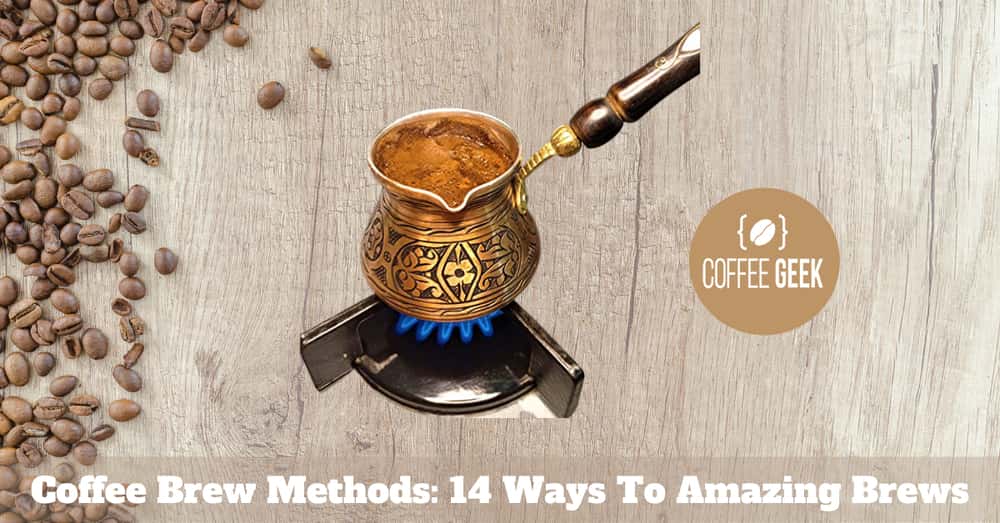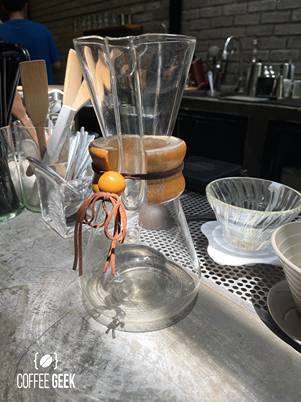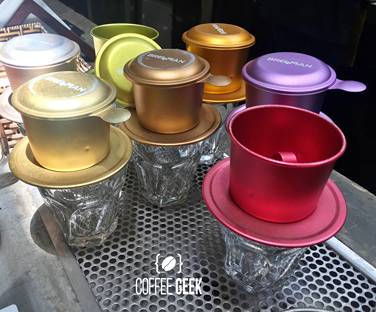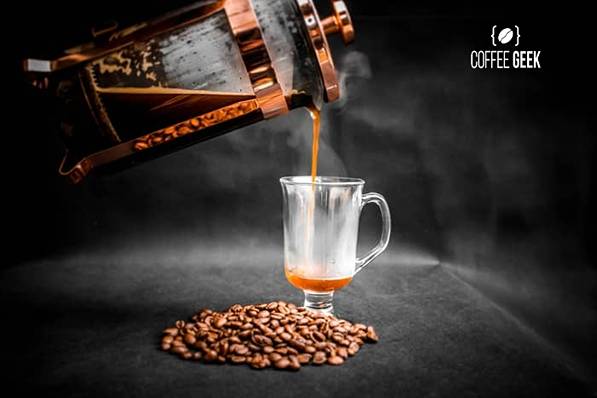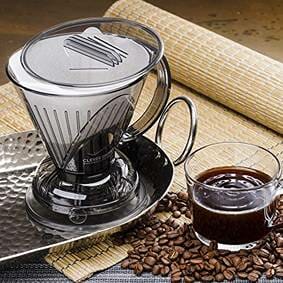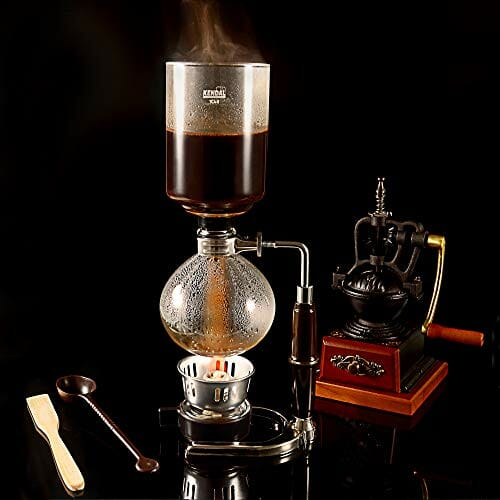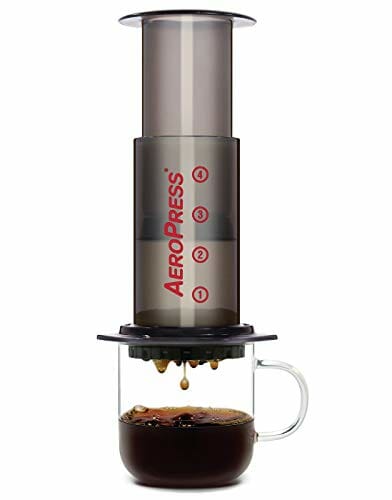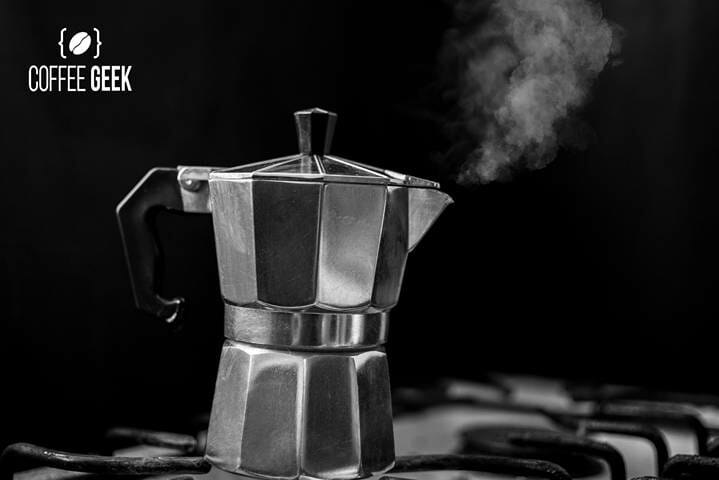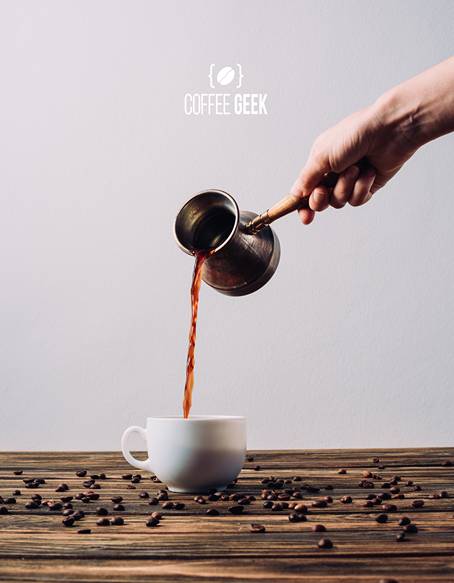When thinking about making coffee at home, the image of an electric coffee maker dispensing a fresh extraction of Joe into the carafe probably comes up in most people’s minds, generally speaking. Well, that assumption is in fact not completely off base.
According to the results of an online survey(1) targeting adult coffee drinkers, in 2020, over 40% of coffee drinkers in the United States reportedly used a drip coffee maker to satisfy their daily caffeine needs, making it the most preferred brew method.
But that’s not all there is to coffee brewing. In this article, I, the coffee geek in resident, will introduce to you 14 exciting coffee brewing methods to expand the horizons of coffee fans.
Drip Coffee
Let’s start from the most popular brewing process then slowly work our way down, shall we?
Drip Coffee Maker
Surely, the drip coffee maker must have got the drip to have been able to stay so well-loved among everyday coffee drinkers for so long.
That drip likely lies in the convenience, speed, and ease in obtaining a satisfying cup of Joe.
Its working mechanism is very simple. The user places coffee grounds inside a paper or metal filter on top of a funnel.
And below the funnel sits a coffee pot into which coffee will drip once brewed.
So, how is coffee brewed? In a separate chamber, water is heated up to a near-boiling point, causing air bubbles to rise through the tubes bringing drops of water with them to eventually reach the funnel.
Thanks to that, hot water is evenly distributed across the coffee ground bed. The extracted coffee compounds follow the water as it makes its way through the coffee grounds and the filter to drip into the previously mentioned coffee pot.
In about 3 to 5 minutes, you can be welcomed with the pleasant aroma of brewed coffee with minimal effort. I suggest grinding the coffee beans yourself before brewing if possible to get the freshest and best quality brew possible.
Who It’s For
A drip coffee machine is suitable for busy coffee lovers who count on ease and convenience to get through the hectic to-do list of the day. Anyone who loves routine and a classic clean and smooth drip black should go for it as well.
If you’re interested in getting one, take a look at our newest review of drip coffee makers.
Pour-Over Methods
Unlike the electric drip coffee makers, you can’t rely on electricity when making a Pour-Over cup of coffee. You have to take everything into your own hand.
Pour-Over is a manual coffee brewing method. Similarly, it also produces drip coffee, but not in the way that electric drip coffee makers do.
A Pour-Over coffee brewer also utilizes a paper filter and a funnel. But rather than having air bubbles pushing water into the filter where the coffee grinds lie, the barista has to manually pour water on top of them.
So that means more time, skills, and effort are involved. But that’s not all. There are various types of Pour-Over coffee brewing devices designed with a different type of funnel that can affect the flow of water and, ultimately, the extraction of coffee as it drips into the final cup.
Hario V60
You can’t mention Pour-Over without mentioning the V60. The name of this iconic dripper cone comes from its original design: a letter V shape with an angle of 60 degrees to optimize coffee-to-water contact time.
The Japanese manufacturer also designed spiral ribs along the dripper to effectively lead the flow of water during the extraction process and allow air to escape as the coffee grounds bed expands.
And, as I’ve briefly mentioned, a paper filter is also used to keep out all of the unwanted coffee oils, bitter notes, and medium-fine coffee grounds, resulting in a cleaner final cup with vibrantly bright notes.
But, unlike the automatic drip machine, you can’t leave your brewing device. You have to stay for the whole 4 minutes and manually control everything:
- The coffee-to-water ratio
- The water temperature (195 – 205 degrees Fahrenheit / 91 – 96 degrees Celsius)
- The speed, the angle, and how long you pour
So you definitely need more than a quick minute of reading the instruction manual to master the craft of making a Pour-Over cup of coffee. To quicken your learning curve, use a gooseneck kettle which can aid you with the pouring process.
It’s also available in multiple sizes and various materials such as glass, ceramic, and plastic. Since this dripper cone is compact, get a plastic one for a portable option.
Who It’s For
Overall, the Hario V60 is for the coffee enthusiasts who have the time and energy to learn to make specialty coffee at home manually or anyone who’s fallen in love with the shape of the Hario V60 and the taste of a bright and clean cup of Pour-Over.
Kalita Wave
Another invention of the Japanese, the Kalita Wave is also a classic that can be considered the more easy-going version of the Hario V60.
This dripper is neatly designed with a wide cone and uniform descending ridges.
And rather than a singular hole at the bottom, Kalita Wave is known for its signature flat bottom with 3 small extraction holes, enabling it to effectively control and restrict the flow of water, ultimately relieving some of the pressure on the skills of the barista.
What you get is an evener and fuller-bodied cup of coffee with a stronger taste despite the usage of paper filters and less risk of an error.
Kalita Wave is available in 2 sizes: 185 for 2 – 3 cups and 155 for single-cup. You mostly see it in its iconic portable stainless steel version but glass and ceramic ones aren’t hard to find either.
Who It’s For
If you don’t care that much about the craft and control for the process, or aren’t confident in your coffee-brewing skills yet love a strong cup of Pour-Over coffee, Kalita can be the answer.
Keep in mind that the Kalita paper filters are a lot more fragile than your usual ones. If it’s not a deal-breaker, it’s definitely worth a shot or two.
Chemex
Chemex is one of the most beautiful Pour-Over coffee brewing methods, in my and likely many others’ opinion.
Chemex sports an hourglass-shaped glass flask with a conical top and a funnel-like neck, like fusing the dripper cone and the carafe. This brewer doesn’t utilize typical filters either.
But unlike the flimsy ones on the Kalita Wave, Chemex’s are special bonded filters that are even thicker than the common ones so they’re able to catch more wandering coffee grounds, oils, and bitter flavor notes.
This means the final cup is a bit cleaner and brighter and more forgiving when it comes to pouring over the water.
Who It’s For
Chemex is perfect for any household with more coffee drinkers that enjoy an exquisite view on their kitchen counter while sipping from the refreshing cup of Pour-Over.
Although the hassle of getting dedicated filters can be bothersome, the feast of the eye and the tongue can definitely change your mind.
Vietnamese Phin
If you happen to miss my article addressing everything you need to know about Vietnamese Coffee, you’ve likely missed this awesome yet simple brewing device called the phin.
A phin is a very small Vietnamese metal filter that slowly produces Vietnamese drip-concentrated coffee. Unlike the other brewing methods that we’ve gone through so far, the Vietnamese phin needs no paper filter for the job.
So how does it work? Once you add ground Robusta coffee beans and near-boiling water to the brewing chamber, extracted coffee slowly drips through the small holes of the perforated plate sitting below the brewing chamber and on top of the coffee glass.
There is also a filter press to tamp the ground coffee into place and a lid to keep heat from escaping during the process of brewing coffee.
You can leisurely enjoy the Vietnamese drip coffee after about 5 minutes using a single-serve phin size of 4 oz (118 ml) or get bigger sizes for larger gatherings.
Who It’s For
The Vietnamese phin is a cheap investment for coffee fans who have fallen in love and want to recreate the delicious Vietnamese drip coffee and iced coffee at home or any adventurer who wants to venture out of the common black drip.
Immersion Methods
Immersion coffee brewing methods are any brewing methods that involve the act of immersing ground coffee beans in hot water to extract coffee compounds.
So, unlike the Pour-Over which asks for water pouring skills, over here, it doesn’t even matter. As long as you have the grind size, coffee-to-water ratio, and water ratio, and immersion time down, you’re golden.
French Press Method
There are 2 types of people in this world. Those who like French Press coffee, and those who don’t like French Press coffee… yet.
French Press, also known as a coffee plunger, press pot, or a cafetiére, is a manual coffee maker that’s the quintessence of the immersion brew method.
The user brews French Press coffee by steeping ground coffee in hot water inside its cylindrical carafe for around 4 minutes. When it’s ready to be served, the user carries out the iconic plunging action by pushing the piston down.
A fine mesh stainless steel filter attached at the bottom of the rod will effectively push down the used grounds, leaving the great coffee on top.
The mechanism of the press pot is simple yet beautifully executed as the whole performance can be observed through the transparent glass carafe.
One drawback of this neat brewer is that extracted coffee is still in contact with the ground coffee at the bottom as the filter doesn’t create an absolute barrier between the two. This means the extraction process still proceeds unless you decant the brewed coffee into a separate container immediately after.
Who It’s For
French Press coffee is for the lovers of fuller-bodied and richer coffee with more intense coffee flavors due to the immersion method and the lack of a coffee filter.
It’s easy enough to pull off and doesn’t require you to stay at its beg and call during the whole brewing process as long as you set a timer. Here’s a detailed guide to making delicious French Press coffee.
Clever Dripper
Its name seems to indicate that it’s a Pour-Over coffee maker. Well, that’s not entirely wrong.
Many say it’s like a lovechild of a French Press and a Pour-Over due to its “clever” design bringing the best of both worlds together.
This is a manual coffee brewing device that incorporates both the immersion and drip methods. Its cone shape and the usage of paper filters are reminiscent of the Pour-Over methods I’ve gone through above.
However, at the bottom, rather than one or many open holes, there’s a stopper (valve) that locks everything in the Clever Dripper to steep. Once you’re satisfied with the immersion time, by placing the dripper on top of a serving cup or carafe, the stopper will lift and great coffee can be drained out.
Who It’s For
This immersion brewer is another quick and easy-to-navigate device that produces a great cup for coffee drinkers who like manually making coffee but not if there’s too much work involved. This device is also worth exploring for anyone who loves French Press and Pour-Over coffee, though it tastes more of the latter than the former.
One icky point that may not meet your personal taste is that it’s only available in BPA plastic, which may look cheap in comparison with fancier-looking devices like the French Press and Chemex. There’s also the issue of discoloration from long-term usage, but that can be solved if you get the colored ones.
Vacuum Pot
Vacuum pot coffee, also known as siphon coffee, is made from an immersion brewing device that also operates as a siphon.
The device has 2 chambers sitting on top of each other. The top one contains ground coffee while the bottom one contains water.
When the bottom vessel is heated up and starts to boil, water vapor is created and expands, pushing the water up through the connecting siphon tube and the filter into the upper vessel.
The hot water remains there during the entire brewing process as long as the water is still being heated and there’s a pressure difference between the 2 chambers.
Once the heat is removed and the pressure in the bottom vessel lowers, gravity drags the extracted coffee down through a filter. The entire process is like watching an hourglass filling each chamber without having to flip it. It’s especially fascinating to watch if you get a glass vacuum pot.
Whew. That was a lot of science. This device also takes double the amount of time to make a cup of Joe compared to your average coffee maker. Taking it apart and cleaning can be a bit overwhelming too.
Who It’s For
So, if you’re a coffee geek like me who’s into trying different coffee gear and doesn’t mind spending time figuring out the trick, this can be an interesting subject.
Espresso Coffee Brewing Method
When you just need a simple energy boost, go for the caffeine-packed shot of espresso. It’s also the base of many Instagram-worthy coffee drinks such as latte and cappuccino.
Espresso Machine
Ranking at number 4th among the most popular brewing methods in America in 2020, the espresso machine has been coming in and out of fashion over the last decade.
But the classic coffee’s flavor that this brewing method brings cements its place in the menu at coffee shops and in the hearts of many coffee aficionados.
This is an Italian coffee brewing method that utilizes high pressure to shoot hot water through a tightly tucked bed of finely ground coffee beans (table salt grind size) to produce a highly concentrated and full-bodied coffee.
For those who are interested in learning more about the espresso beverage and how to make espresso coffee, be my guest and visit some of my previous articles to explore in more detail.
Newer super-automatic models of the espresso machine are equipped with state-of-the-art technologies that can virtually take care of almost everything for you from a few directions on its touch screen.
But for those who’re more traditional and want to control the pull of the espresso shot themselves, semi-automatic ones are always available.
It usually takes only around 30 seconds to pull an espresso shot and some models also have an instant heat-up function as well, though it can take a couple more minutes if you need to steam milk for an espresso-based drink.
Who It’s For
Anyone who wants espresso and espresso-based beverages in their daily life can benefit from investing in getting an espresso machine at home.
There are a variety of options for both the skilled and unskilled baristas and those who welcome a learning curve and those who prioritize convenience. Check out our newest reviews of espresso machines to find your perfect match.
AeroPress Coffee
Although the AeroPress is one of the immersion coffee brewing methods as it works similar to the French Press, AeroPress coffee can be described as being more espresso-style.
This is a manual single-serve coffee brewing device that’s iconic for its syringe-like design. And it works like a syringe as well. After steeping medium-fine grind in hot water in the main chamber, the user inserts the plunger and presses it down to push the good coffee out from the bottom.
Since a paper filter is also used and the brew time is short, despite the fine grind, AeroPress coffee is still vibrant, bright, and flavorful featuring very clear complex notes of the coffee.
Who It’s For
The AeroPress method is for anyone who likes to manually make coffee at home but doesn’t want too much responsibility, doesn’t have enough counter space for an espresso machine, or wants a portable device that they can bring on trips.
Get a more detailed guide to brewing coffee using AeroPress.
Stovetop Coffee
With the following methods, you can brew coffee as long as there’s a heat source.
Moka Pot
If you’re in the coffee scene for long, you must have heard of the Moka Pot. This is another Italian coffee maker.
Moka Pot brews coffee using steam pressure, making it possible to produce good coffee that’s stronger and denser than drip machines, similar to espresso and siphon coffee, which also use pressure for brewing coffee.
Moka Pot has 3 chambers and the bottom one contains water. Sounds familiar, huh?
Even more familiar, the steam pressure that’s generated from the heat pushes hot water through the 2nd chamber containing freshly ground coffee that’s medium-fine. The brewed coffee eventually reaches the top chamber of the Moka Pot.
It can take a bit longer than your typical 4 to 5-minute coffee routine with other methods but it’s generally not hard to pull off.
Who It’s For
Anyone who’s looking for the perfect coffee that’s a thicker alternative to the AeroPress. Moka Pot is also compact, portable, and user-friendly. You can make coffee at home or enjoy a cup of Joe by the camping fire, as long as there are coffee grounds and a heat source.
You can find our reviews of different models of Moka Pot. The most popular one is the Bialetti Moka Pot.
Turkish Coffee
The Turkish coffee method is essentially brewing coffee with a pot. But this pot is more special than your regular kitchen one.
This strong, aromatic, and thick coffee is made using a cezve, or ibrik.
This is a type of Turkish coffee pot with a narrow neck that successfully concentrates and sustains the coffee foam which would get lost in a wide-brimmed pot, giving Turkish coffee the crema that’s similar to espresso.
Since this involves the usage of an open fire, you need to stick to the cezve the entire time. It can also be messy if you don’t pay attention and let it accidentally boil over and spill onto the stovetop.
Who It’s For
This method requires more time and method than you might think to remove the overflowing foam as the coffee is boiling. Definitely not the perfect cup for those who are already rushing enough in the morning as it is.
If you want to spice up your coffee routine at home or the camp or just simply find this brewer fascinating, you should look into getting one of these affordable coffee pots.
Cold Brew Method
Cold Brew coffee is a great undiluted alternative to iced coffee in the summer, although it can take a full day to brew coffee.
I’ve written about how to make Cold Brew before and essentially, there are 2 ways. Both take an incredibly long time to produce the thick coffee concentrate from the cool water and coffee grinds.
Immerse And Filter
You can easily follow this brew method at home by leaving coarsely ground coffee grinds immersed in water in the French Press or AeroPress, go about your day like usual, then come back after 12 to 24 hours to filter and collect your fresh Cold Brew coffee.
The trick is making a whole batch and storing it in an airtight container in the fridge to be consumed over the week.
Who It’s For
Anyone who wants a taste of the refreshingly strong Cold-Brewed coffee but doesn’t have the time to leisurely tend to the coffee batch the whole day.
Slow Drip
The slow drip Cold Brew method is more often seen implemented and displayed at the cafes rather than at home due to the amount of planning and scheduling it takes.
A common tool to carry out this method is the Cold Brew glass tower. Coldwater is slowly dripped through the fresh ground coffee for an extended length of time (6 – 12 hours). But unlike the previous method, you have to stay by the device to adjust the drip rate every other hour.
Who It’s For
Any coffee aficionado who doesn’t mind complicated coffee brewing and welcome new experiences with coffee. Although the process takes a long time, it’s quite beautiful and calming to watch.
To Wrap Up The Best Coffee Brewing Methods
From the most popular coffee brewing methods such as your regular old drip machine to the roads less traveled, from using fancy coffee brewing devices with state-of-the-art technologies to hand-operated devices, I’m sure you can find suitable brew methods to make coffee at home.
(1)https://www.statista.com/statistics/320339/method-of-preparation-among-past-day-drinkers/

